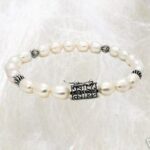There’s nothing more beautiful and alluring than a fine string of pearls. It’s the classic accessory for any occasion. It’s important to understand the nuances of quality before you take the first step towards buying a pearl necklace. They can be quite expensive and you want to get the best value for your money. If you choose a quality string of pearls, you should be able to enjoy them for a lifetime.
In the modern age, most pearls are going to be cultured. This means the mollusk that creates the pearl is given an irritant so the pearl material forms around the foreign body. Surprisingly enough, this process can take up to 3 years to be complete. No wonder pearls are so expensive!
To choose a quality strand of pearls of superior quality, you need to look at several factors:
1. Nacre thickness
Nacre is the substance that forms around the foreign body when a pearl is cultured. It’s the deposit that gives the pearl it’s iridescent property. The thickness of this layer of nacre determines how long your pearls will last. Obviously, the thicker the better. To be considered very thick, a pearl must have at least 0.5 mm of nacre. Medium thick would correspond to 0.35 to .5 mm of nacre, and thin would be 0.25 mm or less.
2. Luster
The longer the pearl is left in the mollusk , the higher the luster. Luster is a reflective sheen seen on the surface of the pearl. This can usually be seen and judged by the naked eye. Do the pearls seem to have an iridescent three dimensional glow? Is the color subtly variegated? These are both signs of high luster and a quality pearl. A low luster pearl will often look flat, monotonous, and one dimensional. You can also examine pearls under a fluorescent lamp to better access luster.
3. Color
In general, darker toned pearls tend to be more valuable than lighter shades of pearls. You can find natural pearls in shades of blue, black, gray, green, and gold, although these shades are not always easy to come upon. Be careful to buy from a reputable dealer before you buy a pearl necklace so you don’t end up with dyed pearls!
4.Shape
Pearls can be found in a variety of shapes including baroque, round, button, stick, and semi round. In general, round, symmetrical pearls tend to be the most valuable since they’re the most difficult to grow.
5. Surface quality
Pearls should be carefully examined against a dark background for the presence of blemishes on their surface. The most valuable pearls are free of natural markings and blemishes.
6. Size
Large cultured pearls tend to be more valuable than smaller ones.
7. Consistency of drilling
Always make sure each pearl is drilled down the center so your pearl necklace will lay properly.
8. Quality of the clasp and workmanship
Examine the necklace closely to make sure, there is a neatly placed knot between each pearl. This prevents the pearls from scratching against one another and adds additional beauty to your necklace design. The clasp should be of high quality in 14 karat gold or higher. If you’re spending this kind of money, you want a gold clasp! In addition, make sure you purchase your pearls from a reputable dealer, preferably one who has some advanced training in gemology with certification in that area.
If chosen wisely, a strand of pearls can be a beautiful addition to your wardrobe and a good investment too. Remember these guidelines before you take the plunge and buy a pearl necklace.



